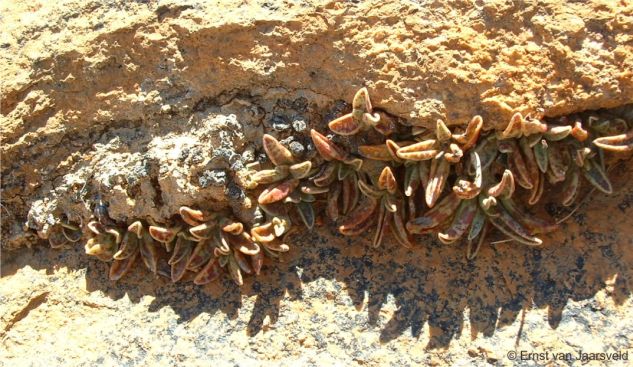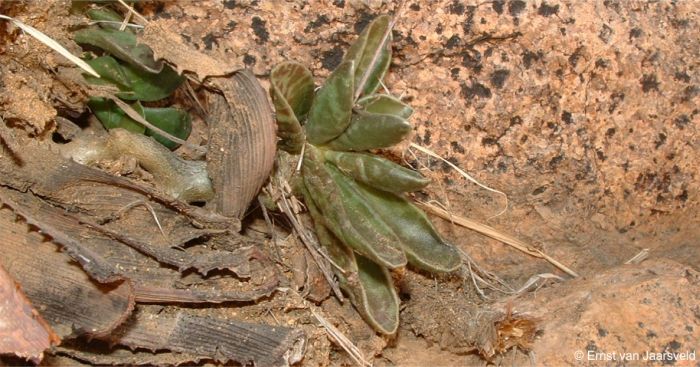Adromischus schuldtianus subsp. brandbergensis
Adromischus schuldtianus subsp. brandbergensis B.Nord. & Van Jaarsv.
Family: Crassulaceae
Common names: Brandberg adromischus (Eng.), Brandbergnenta (Afr.)
Introduction
Adromischus schuldtianus subsp. brandbergensis is a rare, cliff-hugging succulent from the Brandberg in central northern Namibia, it represents the northernmost distribution record of the genus Adromischus. The plants are dwarf, rosulate, leaf and stem succulents, the leaves are dull greyish to reddish, mottled, with a window-like, flat to concave upper surface. It flowers in early summer, the with the tubular flowers yellowish-green with reddish-purple lobes. Best grown in containers.

Fig. 1. An old, established cluster of Adromischus schuldtianus subsp. brandbergensis in a granite crevice, hugging a south-facing cliff near Orabes Wand, Brandberg, Namibia.
Description
Description
Dwarf-sized, mat-forming, cliff hugging, branched succulent, up to 70 mm high, filling crevices in granite rock fissures. Roots fibrous. Branches short, succulent, in cultivation up to 70 × 10 mm. Leaves alternate, spreading, subfusiform-ellipsoid to semiterete, 20–70 × 10–15 mm, without distinct margin, flattened to shallowly concave above, tapering to base, acute-obtuse, often somewhat recurved tip, dark green, marbled with white or dull red areas. Peduncle 150–500 mm long (in cultivation), 1.2–1.5 mm thick, simple or branching above middle, terete, glabrous, greenish brown or reddish, with 2–15 almost patent flowers in a one-sided raceme; bracts 1.5 mm long, acute, succulent; bracteoles 2, basal, subulate, 1 mm long, acute; pedicels 5–17 mm long, somewhat thickened towards apex. Calyx lobes narrowly triangular, 1.8–2.0 mm long, 0.6–1 mm wide, acute. Corolla 12–15 mm long, pinkish white or wax-coloured; tube cylindrical, 2.5–3.0 mm wide; lobes patent, deltoid, acute, with somewhat wavy margins; throat bright purple inside. Squamae oblong, bifid, 1 mm long, 0.8 mm wide, white. Filaments white or pinkish; 5 longer ones adnate for 5 mm, 12 mm long; 5 shorter ones adnate for 3 mm, 10 mm long; anthers 0.4 mm long. Styles subulate-filiform, 5–8 mm long, apically white, basally light green. Flowering is in early summer (November).

Fig. 2. A close-up of an old, established, fruit-bearing cluster of Adromischus schuldtianus subsp. brandbergensis in a granite crevice on a south-facing cliff near Orabes Wand, Brandberg, Namibia.
Conservation Status
Status
Although rare and confined to the Brandberg it is not threatened because the difficult to reach, cliff face habitat is a safe haven for the plants, and its distribution falls within a greater conservation area.

Fig. 3. The Brandberg, a granite massif with the highest peak in Namibia, the habitat of many endemic species including the cliff-hugger, Adromischus schuldtianus subsp. brandbergensis, which grows on south facing cliffs, in crevices.
Distribution and habitat
Distribution description
Adromischus schuldtianus subsp. brandbergensis grows on granite cliffs and steep, south- and east-facing slopes of the Brandberg in northern central Namibia, at altitudes of 500-2 200 m. It is nowhere common, but occurs scattered in protected fissures and crevices, in small to dense groups owing to vegetative proliferation. The Brandberg is an isolated granite inselberg of about 21 × 25 km in diameter and Königstein, at 2 573 m, represents the highest peak in Namibia. It is surrounded by the Namib Desert, with typical species such as Welwitschia mirabilis, annual herbs and grasses. The south-facing aspect where Adromischus schuldtianus subsp. brandbergensis grows, is also the habitat of plants such as Senegalia montis-usti, Aloe littoralis, Aloidendron dichotomum, Cyphostemma currorii, Diospyros acocksii, Ficus ilicina, Kalanchoe lanceolata, Moringa ovalifolia, Obetia carruthersiana, Senegalia hereroensis and Tetradenia riparia. Rainfall in the habitat is about 200–400 mm per annum (on the foothills it is less than 100 mm) and occurs during summer (convectional). The associated vegetation consists of a mosaic of Arid Savanna and Desert.

Fig. 4. The south-facing cliffs of the Brandberg, habitat of Adromischus schuldtianus subsp. brandbergensis. Note the Aloidendron dichotomum (quiver tree) and Senegalia montis-usti in the foreground.
Derivation of name and historical aspects
History
This subspecies was named by Bertil Nordenstam, Braam van Wyk and the author in 2004 in the South African botanical magazine Bothalia, for its place of origin, the Brandberg in Namibia. The plants were first illustrated in 1974 by Bertil Nordenstam when he was preparing a checklist of the Flora of the Brandberg, which was written up in the magazine Dinteria, for which Bertil also prepared a drawing of the plant. The species was named by Von Poellnitz for Hans Schuldt (1929-1970) a German botanist and horticulturist who cultivated many plant species and established an international business marketing seeds. The genus name means ‘thick stem’, derived from the Greek adros, meaning ‘thick’ and miskhos meaning ‘a stalk’.

Fig. 5. The shady south-facing cliffs of the Brandberg in Namibia, habitat of the cliff-hugger, Adromischus schuldtianus subsp. brandbergensis.
Adromischus schuldtianus is one of 3 species of Adromischus that belong to section Boreali, all from northern parts of South Africa and Namibia. In fact it represents the northernmost species in the genus Adromischus. Section Boreali is at once recognized by its tubular flowers of which the petals are usually reflexed against the tube and with protruding anthers. The other members are A. trigynus and A. umbraticola. The latter has the northernmost distribution in South Africa.
The subsp. brandbergensis is at once distinguished from its close relatives by its subfusiform to almost terete leaves, which are distinctly concave on the upper side.

Fig. 6. A close-up of an Adromischus schuldtianus subsp. brandbergensis growing at the base of an Aloe littoralis during the dry season, showing the fleshy stem and the purplish mottled, channelled leaves of the Adromischus.
Helmut Toelken, in 1985, recognised two subspecies for Adromischus schuldtianus, mainly differentiated by their stem and branch length. Adromischus schuldtianus subsp. schuldtianus is characterised by oblanceolate to obovate leaves, its height of 40–80 mm and little branched nature, with branches 10–30 mm long. It occurs in arid savanna in central Namibia, from the Erongo and Auas Mountains in the north to near Aus and the Karas Mountains in the south, growing on rock outcrops, usually with a southern aspect. The subspecies A. schuldtianus subsp. juttae is confined to the Karasberg in southern Namibia and is differentiated by its longer branches and it grows in Nama-Karoo vegetation.
For those interested in Adromischus, see the handbook Adromischus, the Cactus File Handbook published in 1998 by John Pilbeam, Chris Rogerson and Derek Tribble.

Fig. 7. A large established cluster of the cliff-hugger, Adromischus schuldtianus subsp. brandbergensis near Orabes Wand, Brandberg, Namibia.
Ecology
Ecology
Plants form dense clusters and fill up crevices. Branches and leaves rooting where they touch ground. The plants often filling an entire crevice. The succulent leaves and stems store moisture. The alternately arranged leaves are subfusiform-ellipsoid, the flattened adaxial side with a faint window, which can be viewed as an adaptation allowing and spreading light to the abaxial surface in the often shady cliff environment. The subfusiform leaves are typical of many cremnophilous succulent plant species, an adaptation to the harsh cliff habitat. The growth rate of the plants is slow and conservative and plants can become very old.

Fig. 8. A close-up of a cluster of the cliff-hugger, Adromischus schuldtianus subsp. brandbergensis in its native habitat at Orabes Wand, Brandberg, Namibia, during the dry season, the purplish mottled, channeled leaves a response to lack of moisture.
The flowers are tubular, with pink lobes, and are pollinated by insects. The minute seeds are dispersed by wind in summer and autumn, coinciding with the rainy season.
Like other species of Adromischus, this plant proliferates from detached leaves, in nature this is caused by heavy wind or other disturbances It is a vegetative reproductive backup system ensuring the long-term survival of Adromischus schuldtianus subsp. brandbergensis.
Uses
Use
Adromischus schuldtianus subsp. brandbergensis is easy to grow but best for small containers in dappled shade. It is also ideal in miniature succulent container gardens grown with associated cliff-dwelling plants.

Fig. 9. Adromischus schuldtianus subsp. brandbergensis in cultivation in the succulent collection of the Kirstenbosch National Botanical Garden.
Growing Adromischus schuldtianus subsp. brandbergensis
Grow
Adromischus schuldtianus subsp. brandbergensis has a very easy growing nature, which maximises its survival rate. Plants adapt well to small, rock-filled containers. It grows best in dappled shade in a sandy to gritty soil. Plants should be sparingly watered during autumn and spring. Plants rapidly respond to watering, becoming turgid and filling the containers. Plants can be fed with a mild solution of organic fertiliser throughout the year.
Plants are easily propagated by division or leaf cuttings taken in spring or any time during the warmer months. Detach a leaf, and allow it to callus for a week or two. It can simply be placed on the growth medium and the leaves will soon produce roots.
Sow seed in autumn or spring, in a shallow tray, in a sandy mixture and keep moist. Germination is within 3 weeks and once large enough to handle, transfer the seedlings to individual containers. Place the container in a shady position but with full light, the south side of a building is ideal.
Plants are relatively disease free, except for root rot that occurs with too much watering, and aphids, wine weevils, slugs and snails can sometimes be a problem.
References
- Charters, M.L. 2006–2016. The Eponym Dictionary of South African plants. Published online at http://www.calflora.net/southafrica/1Titlepage.html
- Jackson, W.P.U. 1990. Origins and meanings of names of South African plant genera. University of Cape Town.
- Johnson, M.R., et al. 2006. Sedimentary rocks of the Karoo Supergroup. In M.R. Johnson, C.R. Anhaeusser & R.J. Thomas (eds), The geology of South Africa: 463–501. Geological Society of South Africa, Johannesburg Council for Geoscience, Pretoria.
- Mucina, L. & Rutherford, M.C. (eds) 2006. The vegetation of South Africa, Lesotho and Swaziland. Strelitzia 19. South African National Biodiversity Institute, Pretoria.
- Nordenstam, B. 1974. The flora of the Brandberg. Dinteria 11:1–67.
- Pilbeam, J., Rodgerson, C. & Tribble, D. 1998. Adromischus. The Cactus File Handbook 3. Cirio Publishing Services, Southampton.
- Toelken, H.R. 1985. Crassulaceae. Flora of Southern Africa 14: 1–229.
- Van Jaarsveld, E.J. 2010. Waterwise gardening in South Africa and Namibia. Struik, Cape Town.
- Van Jaarsvekd, E.J., Nordenstam, B. & Van Wyk, A.E. 2004. Adromischus schuldtianus subsp. brandbergensis, a new subspecies and a checklist of the succulent flora of the Brandberg, Namibia. Bothalia 34: 35–38.
- Van Jaarsveld, E.J. & Van Wyk, A.E. 2003. New cliff-dwelling Crassulaceae from the Eastern Cape: a new Cotyledon and two new Adromischus taxa from the Mbashe and Mzimvubu Rivers, South Africa. Aloe 40(2): 36–40.
- Von Poellnitz, K. 1940. Zur Kenntnis der Gattungen Cotyledon L. und Adromischus Lem. Feddes repertorium specierum novarum regni vegetabilis, Zeitschrift für systematische Botanik 48: 80–113.
Credits
Ernst van Jaarsveld
Kirstenbosch National Botanical Garden (Retired)
Babylonstoren Farm (Current)
Extraordinary senior lecturer and researcher,
Department of Biodiversity and Conservation, University of the Western Cape
May 2024
Acknowledgements: The author thanks colleagues Adam and Liana Harrower who accompanied him to the Brandberg in 2004.
Plant Attributes:
Plant Type: Succulent
SA Distribution:
Soil type: Sandy
Flowering season: Early Summer
PH: Acid
Flower colour: Green, Purple, Pink, Yellow
Aspect: Shade, Morning Sun (Semi Shade)
Gardening skill: Average
Special Features:
Horticultural zones







Rate this article
Article well written and informative
Rate this plant
Is this an interesting plant?
Login to add your Comment
Back to topNot registered yet? Click here to register.